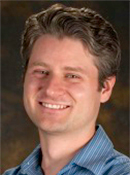Christian P. Petersen Molecular and cellular basis of regeneration
Research Interests
Regeneration is widespread in nature but poorly understood due to the underrepresentation of regenerative abilities among most model organisms. Regenerating animals are confronted with unique challenges that defy explanation—production of fully differentiated structures starting from an adult rather than embryonic context, integration of newly regenerated and previously existing tissues, and specification of the identity of regenerating tissues. What molecular and cellular processes do regenerating animals use to solve these problems? We are addressing these problems by turning to an animal model that possesses almost unlimited regenerative abilities, the planarian Schmidtea mediterranea. These animals possess stem cells of high potency, termed neoblasts, as well as finely tuned regulatory systems that enable them to replace any adult tissue removed by injury, including after decapitation, and also replace old tissues continually to attain indefinite lifespans. They can be reared in large numbers and probed by functional genomics and whole-animal histology to unravel the molecular basis for regenerative abilities.
We have investigated the biology of this organism to define the critical regulators, pathways, and principles underlying the molecular and developmental biology of regeneration. Our ongoing efforts address several major fundamental questions in regeneration biology that are as-yet unanswered: How do regenerating animals “know” what tissues are damaged or missing? What triggers regenerative outgrowth? How do regenerating animals control the extent and scale of growth? Is it possible to enhance regenerative repair? We have discovered that regeneration involves the use of stem cells to produce tissue organizing centers necessary for regenerative outgrowth, it requires long-range signaling that specifies the identity of tissues present/absent after injury, it uses spatial feedback inhibition to determine the extent of the regeneration response. In addition, we have begun to define pathways that control stem cell abundance, that assemble progenitors into functional tissues, and that act to limit regenerative ability. Regenerative processes are likely to be ancient and conserved, and therefore elucidating mechanisms governing extreme regeneration can identify targets for the enhancement of human tissue repair as well as inform future efforts to produce organs synthetically.
Selected Publications
STRIPAK Limits Stem Cell Differentiation of a WNT Signaling Center to Control Planarian Axis Scaling. Schad EG and Petersen CP. Current Biology. 2020 January 20;30(2):254-263.E2.
tec-1 kinase negatively regulates regenerative neurogenesis in planarians. Karge A, Bonar NA, Wood S, and Petersen CP. eLife. 2020 January 20;9:e47293.
Positional information specifies the site of organ regeneration and not tissue maintenance in planarians. Hill EM and Petersen CP. eLife. 2018 March 16;7:e33680.
Activation of planarian TRPA1 by reactive oxygen species reveals a conserved mechanism for animal nociception. Arenas OM, Zaharieva EE, Para A, Vásquez-Doorman C, Petersen CP, and Gallio M. Nature Neuroscience. 2017 December;20(12):1686-1693.
Integrin suppresses neurogenesis and regulates brain tissue assembly in planarian regeneration. Bonar NA and Petersen CP. Development. 2017 March 1;144(5):784-794.
View all publications by Christian P. Petersen listed in the National Library of Medicine (PubMed). Current and former IBiS students in blue.
